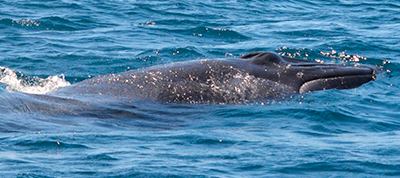Compared to 2023, when sightings of fin whales (Balaenoptera physalus) were mostly recorded in July and August, this year’s sightings were predominantly in May and June, with a few occasional spottings in the summer and autumn months. Although there were numerous sightings It is still not possible to pinpoint specific migration or passage periods in the Sesimbra and Arrábida area.
It is worth noting that in May and June, the fin whales were observed feeding consistently in the same area, which contrasts with previous years, when they were observed traveling at speeds of up to 10 knots, heading north at about 2 to 3 nautical miles from the coast. This suggests that the feeding behavior this year was different from the moving patterns observed in prior years.
The region's marine area is marked by several submarine canyons and unique geological formations. Rich in biodiversity and krill, it serves as an essential feeding ground for this whale specie during its migratory journey, especially in the waters south of Cape Espichel.
For the first time, we observed a Bryde's whale (Balaenoptera brydei), also known as the tropical whale, marking our first documented sighting in the Sesimbra area. Although its behavior and size are similar to other species - it is sometimes confused with the Sei whale (Balaenoptera borealis), Bryde’s whales can be easily identified by specific anatomical features. They are the only large rorqual species to have three longitudinal ridges running from their blowholes to the tip of their rostrum. This distinctive feature helped us confirm the species and record the sighting (photo).
One of the most remarkable moments of the year occurred on the 28th of October when we observed a juvenile fin whale breaching (jumping) just 10-15 meters from the boat (clip). This behavior, known as "breaching," was captured on camera for the first time this year.
Breaching is believed to serve several purposes: (1) as a form of communication between individuals, (2) to establish territory, and (3) for visual observation. The fin whale, the second largest animal on Earth, can reach up to 20 meters in length and weigh as much as 48 tonnes, making it second only to the blue whale (Balaenoptera musculus).
In 2024, the fin whale was the most commonly sighted whale species on Bolhas Tours’ daily dolphin and whale watching trips in Sesimbra´s seas.
These sightings are crucial for expanding our knowledge of North Atlantic´s whales and dolphins populations that visit the coast of Sesimbra and Arrábida for feeding and birthing. In our tours essential data is collected to supply national institutes for the development of conservation and protection policies aimed at preserving this unique and vital ecosystem.
“I´am tormented with an everlasting itch for things remote. I love to sail forbidden seas, and land on barbarous coasts.”
Herman Melville, in Moby Dick


